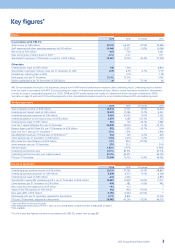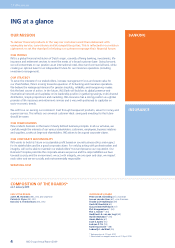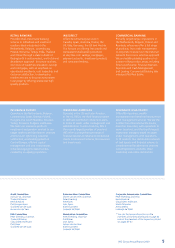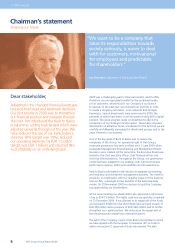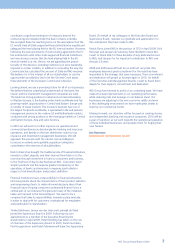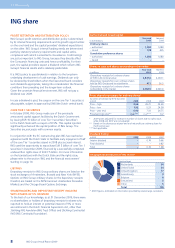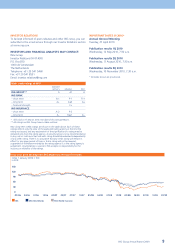ING Direct 2009 Annual Report Download - page 13
Download and view the complete annual report
Please find page 13 of the 2009 ING Direct annual report below. You can navigate through the pages in the report by either clicking on the pages listed below, or by using the keyword search tool below to find specific information within the annual report.
ING ENTERING INTO TRANSACTIONS WITH
THE DUTCH STATE
The rapidly worsening conditions following the summer of 2008
fuelled an internationally recognised belief that capital requirements
for financial institutions had to be raised. In order to create a strong
buffer to navigate the challenging environment, ING therefore
decided to strengthen its capital position in October 2008 by
issuing EUR 10 billion of core Tier 1 securities to the Dutch State.
Under the terms of the agreement we obtained the right to buy
back all or some of the securities at any time at 150% of the issue
price. In addition, we obtained the right to convert all or some of
the securities into (depositary receipts for) ordinary shares on a
one-for-one basis, from three years after the issuance onwards.
It was also agreed that should ING choose to do so, the Dutch
State would be able to opt for repayment of the securities at
EUR 10 each in cash. The coupon on the core Tier 1 securities will
only be payable if a dividend – either interim or final – was paid on
common shares over the financial year preceding the coupon date.
This transaction enabled ING to strengthen its capital position
significantly.
In the fourth quarter of 2008 market conditions deteriorated even
further, making it the worst quarter for equity and credit markets in
over half a century. Market prices for residential mortgage-backed
securities (RMBS, including Alt-A classified RMBS), collateralised
debt obligations (CDOs) and collateralised loan obligations (CLOs)
fell sharply as liquidity dried up. This eventually affected ING’s
results and equity more than expected, in particular due to ING’s
portfolio of Alt-A RMBS. We therefore entered into an agreement
with the Dutch State on an Illiquid Assets Back-up Facility (IABF)
covering 80% of our Alt-A RMBS.
Under the terms of the IABF, a full risk transfer to the Dutch State
was realised on 80% of our approximately EUR 30 billion par value
portfolio of Alt-A RMBS at ING Direct USA and ING Insurance
Americas. As a consequence, the Dutch State now participates in
80% of any results of the portfolio. The risk transfer took place at
a discount of 10% of par value. In exchange, the Dutch State was
to pay a funding fee and principal payments on two Government
receivables to ING. The first receivable initially had a funding fee
of 3.5%, the second receivable initially had a funding fee of Libor
+50 basis points (please note that these fees were revised following
discussions with the European Commission, which will be discussed
below). ING remained the legal owner of 100% of the securities
with an exposure of 20% to the portfolio’s results. The transaction
significantly strengthened ING’s capital and balance sheet as it
resulted in a reduction of equity volatility. Moreover, it had a
positive impact on shareholders’ equity amounting to EUR 5 billion
through a reduction of the negative revaluation reserve.
BACK TO BASICS
FIRST PHASES
In April 2009 we introduced our Back to Basics programme:
a strategic change programme to stabilise the Company, restore
credibility and regain trust, with the ultimate objective of
sharpening focus and creating a more coherent set of activities.
First, the implementation of the programme involved a series of
measures to strengthen the Company’s financial position through
cost containment, reductions of risk and capital exposures, and
deleveraging the balance sheet by reducing asset exposures and
preserving equity.
Over the course of 2009 we completed this first phase of our Back
to Basics programme, exceeding each of the targets set. Operating
expenses were reduced by EUR 1.5 billion, exceeding both the
original target of EUR 1 billion as well as the increased target
of EUR 1.3 billion on a comparable basis, of which approximately
EUR 1.2 billion represent sustainable savings and EUR 0.3 million
were one-off items. The expense figures have been adjusted for
acquisitions and divestments, as well as impairments on real estate
development projects and the charge for the Dutch deposit
guarantee scheme related to DSB Bank. Headcount reductions
totalled 11,331, including divestments, surpassing the expected
reduction of 7,000 FTEs. Derisking measures progressed well and
continued in the fourth quarter. ING Direct sold EUR 0.8 billion of
its US prime RMBS portfolio, realising a loss of EUR 83 million, but
releasing EUR 7 billion of risk-weighted assets. Deleveraging of the
bank’s balance sheet also exceeded the original target, reaching
EUR 194 billion, or 18.0%, compared with the end of September
2008 when the balance sheet reductions began.
Secondly, we announced a strategic review of our portfolio with
the objective of identifying measures to simplify the Group,
increase our strategic focus and create a more coherent set of
activities. In order to simplify the organisation, we decided to
operationally separate the management of our businesses, into
one Bank aiming for an integrated balance sheet and one Insurer/
Investment Manager under the umbrella of the Group. In addition,
the portfolio review made clear that a group of smaller businesses
within ING Group consumed a disproportionate amount of capital,
given the fact that they did not have a clear outlook for market
leadership. To address this over-extension, we made a number
of portfolio choices based on market leadership, capital intensity,
return on capital, funding needs, earnings contribution and the
overall coherence of the Group.
We decided to reduce our geographic and business scope by
concentrating on positions in markets with the strongest franchises.
As a consequence, we announced and completed a number of
significant divestments over the course of 2009. These included our
Annuities business in Argentina, ING Canada, our life insurance and
wealth management venture in Australia and New Zealand, Private
Banking Switzerland, Private Banking Asia, ING Reinsurance US,
three of our US independent retail broker-dealer units, and our
Annuity and Mortgage businesses in Chile. The proceeds of these
divestments amounted to EUR 3.8 billion and freed up EUR 2.7
billion of capital.
In July, we announced that the formerly separate organisations
of Nationale-Nederlanden, RVS and ING Verzekeren Retail
(formerly Postbank Verzekeren) in the Netherlands were to be
combined into one customer-oriented organisation under the
Nationale-Nederlanden brand. The new insurance organisation
will have dedicated business units for retail customers, small and
medium-sized enterprises, and corporate clients.
Meanwhile, we managed to turn around our commercial
performance. While implementing the first phases of the Back to
Basics programme and redefining the strategic direction of the
ING Group Annual Report 2009 11




